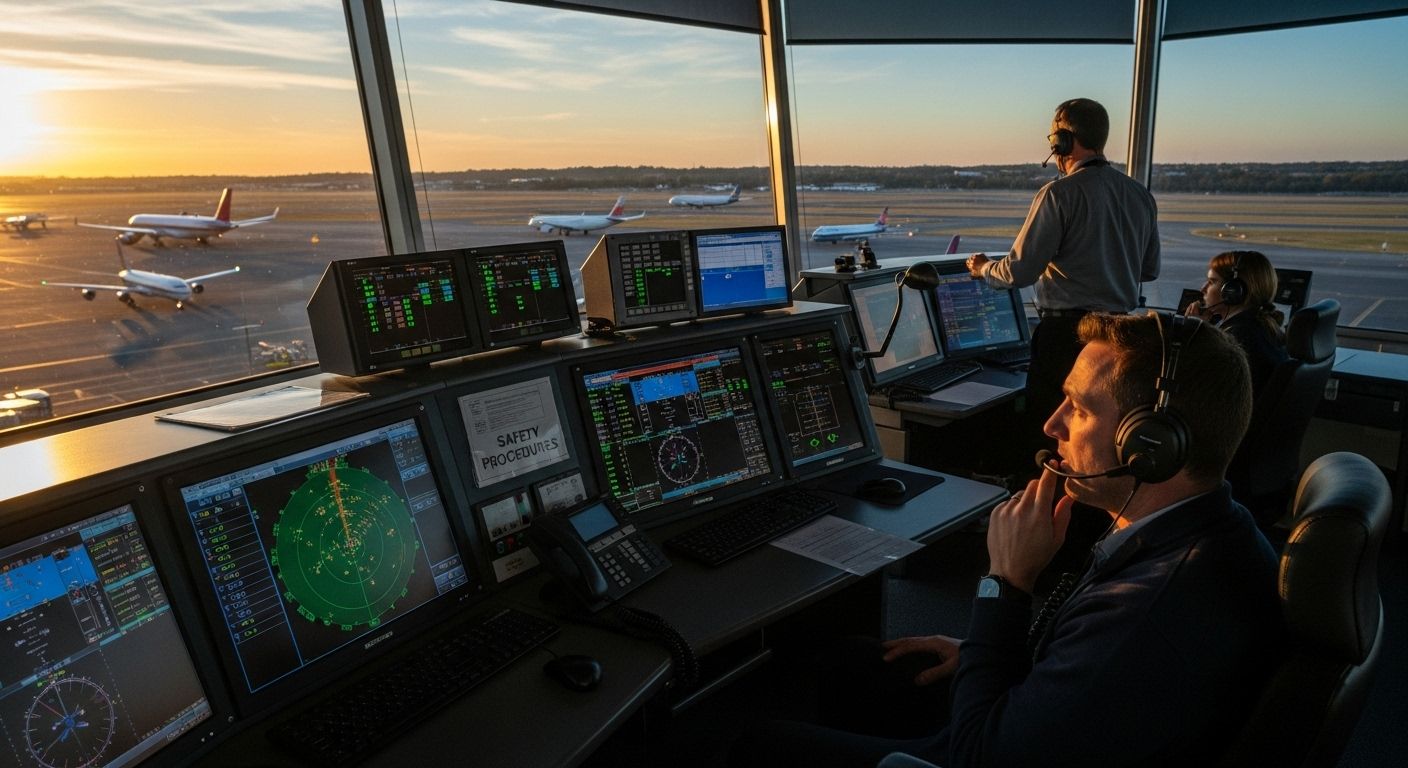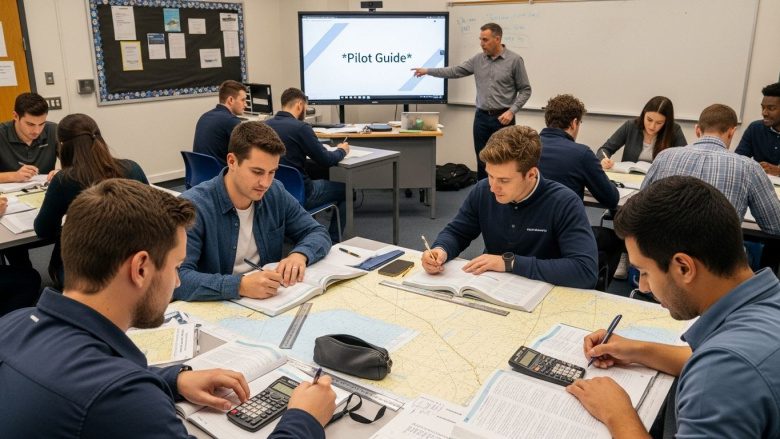Every time a plane takes off, the safety of hundreds of lives depends on invisible routines and unwavering discipline. Most passengers are unaware that aviation safety procedures address every stage of flight, from meticulous pre flight checks to constant risk assessment by crew members. Yet even the most thorough guidelines are not carved in stone. The real surprise is that these procedures are designed to evolve constantly, adapting to new challenges and discoveries so air travel remains safer than ever.
Table of Contents
- What Are Aviation Safety Procedures And Their Purpose?
- The Importance Of Aviation Safety Procedures In The Industry
- Key Concepts Underpinning Aviation Safety Procedures
- How Aviation Safety Procedures Are Developed And Implemented
- Real-World Applications And Case Studies In Aviation Safety
Quick Summary
| Takeaway | Explanation |
|---|---|
| Aviation safety procedures mitigate risks. | They are designed to protect passengers and crew during all phases of flight operations by ensuring high safety standards. |
| Collaboration is key for effective safety. | Implementation requires coordinated efforts from pilots, ground crew, air traffic controllers, and regulatory bodies. |
| Continuous monitoring enhances risk management. | Ongoing assessments and reporting help to proactively identify hazards and prevent incidents before they occur. |
| Safety procedures evolve with technology. | They are dynamic frameworks that adapt based on technological advancements and lessons learned from incidents. |
| Preventative strategies are essential for aviation safety. | Focused on anticipating challenges, these strategies create multi-layered defenses against potential aviation risks. |
What Are Aviation Safety Procedures and Their Purpose?
Aviation safety procedures represent a comprehensive system of protocols, guidelines, and practices designed to mitigate risks and ensure the highest possible level of safety in air transportation. These meticulously developed frameworks are critical for protecting passengers, crew members, and aircraft during all phases of flight operations.
The Core Components of Aviation Safety Procedures
At their foundation, aviation safety procedures encompass a range of strategic measures that address multiple dimensions of air travel safety. These include:
- Detailed pre flight risk assessments
- Systematic equipment and aircraft maintenance protocols
- Comprehensive crew training and emergency response strategies
- Rigorous communication and reporting mechanisms
Learn more about safety management practices that underpin these critical procedures.
Objectives and Implementation
The primary objectives of aviation safety procedures are multifaceted. According to European Union Aviation Safety Agency, these procedures aim to:
- Proactively identify potential hazards in air transportation
- Develop systematic risk mitigation strategies
- Establish clear operational guidelines for different flight scenarios
- Create a culture of continuous safety improvement
Effective implementation requires collaboration between pilots, ground crew, air traffic controllers, and regulatory bodies. Each stakeholder plays a crucial role in maintaining the intricate safety ecosystem of aviation.
These procedures are not static documents but dynamic frameworks that evolve with technological advancements, lessons learned from incident investigations, and emerging global aviation challenges.
The following table outlines the core components of aviation safety procedures, providing a concise summary of each key area mentioned in the article.
| Core Component | Description |
|---|---|
| Pre flight risk assessments | Evaluating potential hazards and addressing safety concerns before every flight. |
| Equipment and aircraft maintenance | Systematic checks and servicing routines to ensure operational integrity of all systems. |
| Crew training and emergency response | Comprehensive instruction in standard procedures and handling emergency scenarios. |
| Communication and reporting mechanisms | Rigorous methods for transparent information sharing and hazard reporting among all parties. |
| They represent a holistic approach to safety that goes beyond mere compliance, focusing on creating an integrated system of risk management and prevention. |
This table compares the primary objectives and implementation features of aviation safety procedures, helping clarify the distinction between the intention behind safety protocols and their practical application.
| Aspect | Objectives | Implementation Features |
|---|---|---|
| Hazard Approach | Proactively identify and mitigate risks | Collaboration between pilots, crew, controllers, and regulators |
| Guideline Focus | Establish clear operational frameworks for various flight scenarios | Regular training programmes and professional development requirements |
| Improvement | Continuous safety enhancement based on incidents and new information | Ongoing audits, performance assessment, and documentation |
| Overall Culture | Promote a systemic commitment to safety, beyond mere compliance | Multilayered, technology-enabled systems that adapt to changes and challenges |
The Importance of Aviation Safety Procedures in the Industry
Aviation safety procedures are fundamental to maintaining the integrity, reliability, and public confidence in air transportation. These comprehensive frameworks serve as the critical backbone of modern aviation, ensuring that every flight operates under the most stringent safety standards possible.
Economic and Human Impact
The significance of aviation safety procedures extends far beyond technical compliance. These procedures directly impact human lives and global economic systems. A single aviation incident can result in substantial financial losses, reputational damage, and potentially catastrophic human consequences. By implementing robust safety protocols, the aviation industry protects not just individual passengers, but entire transportation ecosystems.
Explore advanced safety management techniques that drive industry standards.
Preventative Risk Management
According to European Union Aviation Safety Agency, aviation safety procedures are designed to be proactive rather than reactive. Key preventative strategies include:
- Continuous monitoring of operational risks
- Regular equipment and personnel performance assessments
- Comprehensive incident reporting and analysis systems
- Ongoing professional training and skill development
These strategies create a multilayered defense mechanism that anticipates potential challenges before they become critical problems. The goal is not just to respond to incidents, but to prevent them from occurring in the first place.
By treating safety as a dynamic, evolving discipline, the aviation industry demonstrates its commitment to protecting human life and maintaining the highest possible operational standards. Safety procedures represent a complex, interconnected system of knowledge, technology, human expertise, and regulatory oversight that continues to push the boundaries of what is possible in secure, reliable air transportation.
Key Concepts Underpinning Aviation Safety Procedures
Aviation safety procedures are built upon a sophisticated framework of interconnected principles that form the foundation of risk management and operational excellence in air transportation. These fundamental concepts represent a complex, holistic approach to ensuring the highest possible safety standards across the global aviation ecosystem.
Core Philosophical Foundations
Safety is not just a technical requirement but a comprehensive cultural commitment. This philosophy recognizes that effective aviation safety goes beyond mere compliance with regulations. It involves creating an environment where every stakeholder understands their critical role in maintaining operational integrity.
Explore comprehensive safety management techniques that transform theoretical concepts into practical implementations.
Primary Conceptual Pillars
According to European Union Aviation Safety Agency, the key conceptual pillars of aviation safety procedures include:
![]()
- Proactive Risk Assessment: Identifying potential hazards before they manifest
- Continuous Learning: Systematically analyzing incidents and near-misses to prevent future occurrences
- Transparent Reporting: Encouraging open communication about potential safety concerns
- Systemic Approach: Viewing safety as an integrated, interconnected system rather than isolated procedures
Operational Implementation Strategies
Translating these conceptual foundations into practical operational strategies requires a multidimensional approach. Aviation safety procedures operate on the principle of creating multiple layers of protection, where each layer provides redundancy and comprehensive risk mitigation.
This approach ensures that even if one safety mechanism fails, multiple additional safeguards remain in place. The dynamic nature of these procedures allows for constant adaptation to technological advancements, emerging global challenges, and evolving industry insights.
By integrating human expertise, technological innovation, and rigorous regulatory frameworks, aviation safety procedures continue to push the boundaries of what is possible in creating secure, reliable air transportation systems.
How Aviation Safety Procedures Are Developed and Implemented
The development and implementation of aviation safety procedures represent a sophisticated, multilayered process involving numerous stakeholders, regulatory bodies, and complex systematic approaches. These procedures are not static documents but dynamic frameworks that evolve continuously in response to technological advancements, incident analyses, and emerging global challenges.
Collaborative Development Process
Aviation safety procedures are created through an intricate collaborative ecosystem involving international regulatory agencies, aviation experts, airlines, manufacturers, and research institutions. Discover advanced safety management frameworks that drive this comprehensive development process.
According to European Union Aviation Safety Agency, the development process typically involves:
- Comprehensive data collection and risk analysis
- Extensive consultation with industry stakeholders
- Rigorous scientific and technical evaluations
- Systematic review of global aviation incident reports
- Continuous refinement based on emerging technological capabilities
Implementation and Enforcement Mechanisms
Implementation of aviation safety procedures requires a robust, multifaceted approach that transcends mere regulatory compliance. This involves creating integrated systems that translate theoretical guidelines into practical, actionable protocols across different operational contexts.
Key implementation strategies include:
- Mandatory training programmes for aviation professionals
- Regular safety audits and performance assessments
- Standardized documentation and reporting mechanisms
- Continuous professional development requirements
- Technology-enabled monitoring and verification systems
The ultimate goal of these development and implementation processes is to create a proactive, adaptive safety environment that anticipates potential risks before they can manifest, ensuring the highest possible standards of safety and operational excellence in air transportation.
Real-World Applications and Case Studies in Aviation Safety
Real-world applications of aviation safety procedures demonstrate the critical importance of systematic risk management and continuous learning in preventing potential incidents. These practical implementations transform theoretical guidelines into tangible protective mechanisms that safeguard human lives and operational integrity.
Practical Risk Mitigation Strategies
Explore advanced safety management techniques that translate conceptual frameworks into actionable safety protocols.
According to European Union Aviation Safety Agency, practical applications typically involve:
- Comprehensive incident investigation and analysis
- Development of targeted corrective action plans
- Implementation of technological and procedural improvements
- Systematic knowledge sharing across aviation organizations
- Continuous performance monitoring and feedback mechanisms
Transformative Case Study Examples
Specific case studies illustrate how aviation safety procedures prevent potential catastrophic events. Successful interventions often result from meticulous analysis of near-miss incidents and proactive risk management. Real-world scenarios demonstrate how:
- Detailed cockpit communication protocols have reduced human error
- Advanced sensor technologies enable early detection of mechanical anomalies
- Standardized emergency response training saves lives during critical situations
- Integrated safety management systems predict and mitigate potential risks before they escalate
These practical applications represent a dynamic, evolving approach to aviation safety, where continuous learning and technological innovation combine to create increasingly sophisticated protective frameworks. By transforming data into actionable insights, the aviation industry demonstrates an unwavering commitment to ensuring the highest possible safety standards across global air transportation systems.

Turn Aviation Safety Knowledge Into Qualification
Mastering aviation safety procedures is not just about understanding regulations. For many aspiring pilots, the real challenge lies in transforming this essential knowledge into professional skill and internationally recognised qualifications. Navigating risk assessment, incident reporting, and regulatory compliance can feel overwhelming without the right support. The desire to achieve EASA-approved certification while balancing flexibility, accessibility, and expert guidance is critical for career growth.
Explore our Academy for tailored pilot training

Take your next step from safety theory to cockpit readiness with VictorOne.eu. Empower yourself through fully online, comprehensive courses covering every aspect of modern aviation safety. Seamless access to interactive resources, expert online consultations, and internationally accepted exams means your professional future can start now. Ready to put your understanding of aviation safety procedures into practice? Visit our Academy to enrol or discover even more opportunities on VictorOne.eu today.
Frequently Asked Questions
What are aviation safety procedures?
Aviation safety procedures are comprehensive protocols and guidelines designed to mitigate risks and ensure safety during air transportation, covering all phases of flight operations.
Why are aviation safety procedures important?
They are crucial for maintaining public confidence, protecting human lives, and ensuring that flights operate under stringent safety standards, ultimately safeguarding the aviation ecosystem.
How are aviation safety procedures developed?
These procedures are developed through a collaborative process involving regulatory bodies, aviation experts, and industry stakeholders, focusing on data collection, risk analysis, and continuous refinement based on global incident reports.
What is the role of technology in aviation safety procedures?
Technology plays a vital role by enabling real-time monitoring, enhancing incident reporting systems, and facilitating advanced training techniques, all contributing to the proactive management of risks in aviation.


